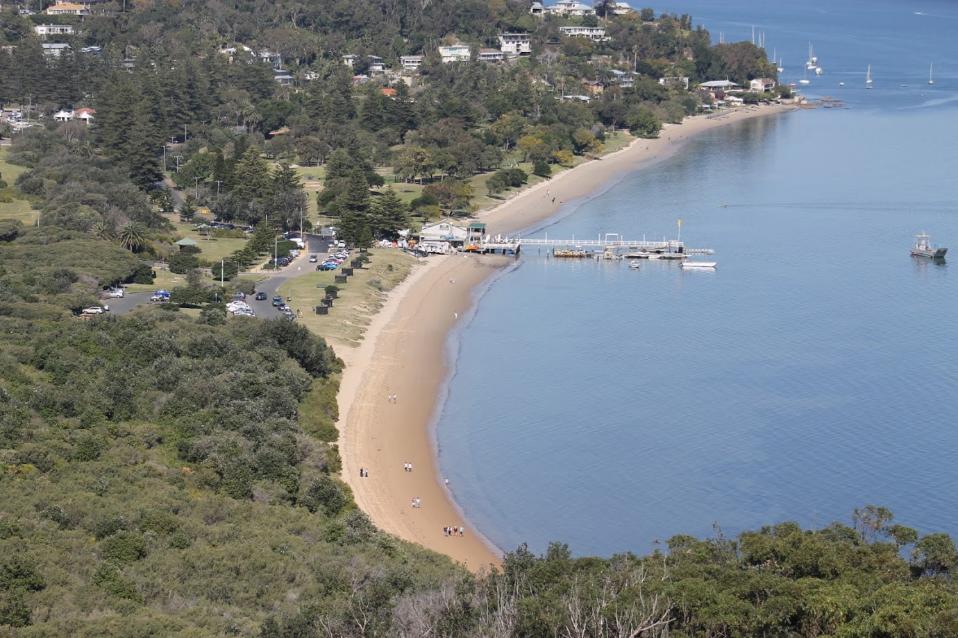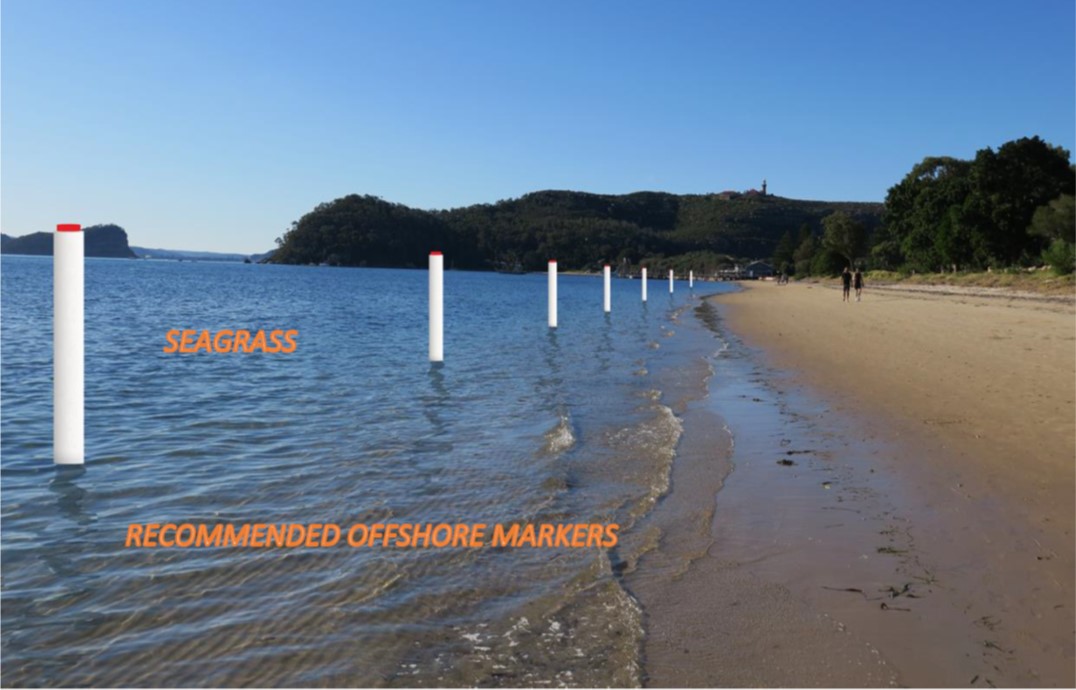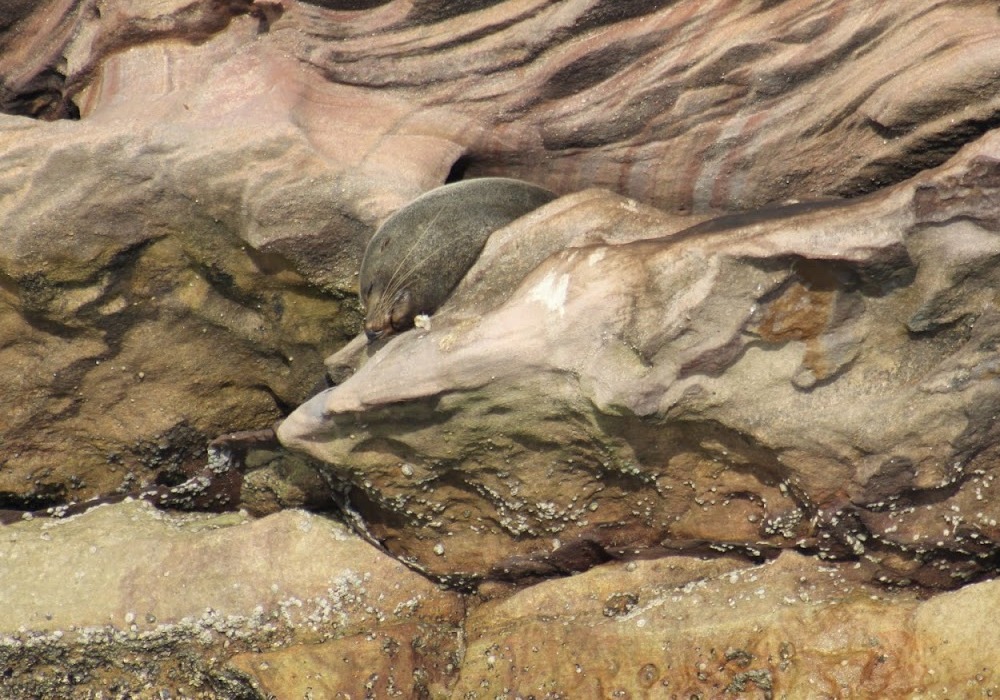REF for station Beach Dog Trial Recommends over 30 Mitigation & monitoring measures in order to proceed: Omits mention of resident seal and little penguin colonies

Barrenjoey/Station Beach.
The Review of Environmental Factors for the Station Beach off-leash dog trial has recently been made available by Council, inviting feedback from residents.
Concerns the Station Beach REF has not taken into account the Australian Seal Colony on Barrenjoey Headland or the Little Penguin (Fairy Penguin) colony on Lion Island, with both species seen regularly in the Pittwater estuary, are among a list of omissions residents have forwarded this week. These two long-term aquatic residents not being listed in the REF stands out in a week where local students have presented their efforts in support of the 2019 Project Penguin that celebrates and aims to ensure the continuation of Little Penguins at Manly and the news running in this Issue about the hard work of others to ensure the next generation gets to see Lion Island's Little Penguins too.Not robbing those now growing tall or those yet to come of what we have enjoyed stands out at such times of positive actions. Who could or would claim a right to do so anyway?
The whole of Station Beach becoming a 'dog beach' and excising this area to the exclusion of all other residents, including the thousands of year round annual visitors to Palm Beach, has also been raised in a series of emails sent in to Pittwater Online News.
Along with the REF recommended installation of offshore markers to 'protect the endangered seagrass beds'.

There are also expressions of disappointment that when the NSW Government Department of Industry expressed their major environmental concerns to the Council in their letters of 10 September 2018 and 15 November 2018, and preference for Council to evaluate alternative sites, that this was not followed up on.
Is there somewhere safer to both the residents with dogs that love a dip and their dogs too? Somewhere that won't impact on resident fauna? Won't impact on the hundreds of thousands of tourist visitors? Somewhere with safer parking? With sand that is groomed should someone negate to pick up their dogs' 'leavings'?
Although the REF lists over 30 mitigation and monitoring measures that will be required to run the trial no costings for these measures are available as yet.
The REF also acknowledges that many animal species, including birds such as the Critically Endangered Eastern Curlew, Far Eastern Curlew and Curlew Sandpiper are 'likely to occur within area' - and as residents have taken photographs of these species within the area, 'likely to occur' could have been listed as 'present' with a little more research. Other endangered species, known to occur within the area are listed as such - the turtles, the sea horses, the wealth of sea birds that frequent the national park end of this beach and its adjacent sands and waters.
REF KEY POINTS:
- Installation of Unsightly Offshore Boundary Markers/Piers
- No Dog Swimming During Low Tides
- Over 30 Monitoring and Mitigation Measures
- Undisclosed Costs, Safety, Traffic & Local Issues Ignored
- Ignores Concerns by the Department of Industry
TRIAL IMPLICATIONS:
- 100% takeover of Station Beach to become a dog’s beach
- Change of Use of the beach to the exclusion of others
- A row of permanent offshore markers/piers, defacing this pristine beach
- Will worsen traffic and parking congestion
- Poor environmental legacy for the next generation
REF Recommendations:
1. Introduce a three (3) metre Buffer Zone Line in front of the seagrass bed, to run parallel to the beach, defining the Dog Swim Area (DSA). Dogs permitted to swim east of this Line.
2. Install a series of offshore boundary markers/piers to visually define the Buffer Zone Line.
3. Introduce in excess of 30 monitoring/mitigation requirements, including signage (REF acknowledges high likelihood that this will be ignored, observing first hand off-leashed dogs trampling and defecating on the seagrass), offshore boundary markers (quantity and height not covered), regular environmental management (water and seagrass testing), and extra ranger patrols (how many and at what cost are not itemised).
REF Environmental Issues:
1. Seagrass beds off Station Beach provide an important fish habitat, and are recognised as being “threatened” and “endangered.”
2. REF acknowledges seagrass and fish habitat will be put at further risk by the off-leash dog trial, mainly at low tide.
3. REF acknowledges off-leash dogs can disturb wildlife such as migratory birds.
4. Trial challenges Council’s & NSW Government’s environmental and sustainability principles regarding the safeguarding of coastal ecosystems.
Implications of Recommendations:
1. REF notes dogs will NOT be able to swim in the DSA during low tides – this defeats the key objective of the trial – to provide a continuous swim area for off-leash dogs.
2. A massive waste of time, effort and resources to accommodate off-leash dogs who can only swim at high tide, and only if it coincides with the proposed morning and afternoon times.
3. At high tide the beach is narrow, introducing conflict and safety issues with other users of the beach.
4. Proposed seagrass protection buffer will require multiple unsightly offshore boundary markers/piers, which will deface Station Beach as an iconic estuarine and pristine beach and as a popular tourist attraction.
5. “Change of Use” of the beach from a safe and peaceful beach to an effective “dog’s beach.”
Other Issues / Shortcomings of the REF:
1. Lack of fencing and conflict / safety concerns for multiple users of the beach (elderly, young families, visitors, joggers, tourists vs off-leash dogs) and the neighbouring golf course, were not addressed in the REF.
2. REF overlooks entire trial area commencing from the southern Beach Road entrance and completely ignores local residents’ concerns to their property and the surrounding area, including current off-leash illegal activity on Station Beach, and adverse impacts over the recent quasi summer trial.
3. Parking and traffic congestion issues not adequately addressed in the REF.
4. REF fails to assess and address local community and environmental issues raised in submissions, including health issues associated with dog pollution.
5. REF’s scope is restricted to Station Beach despite its clear unsuitability. The 2008 REF investigated many alternative sites.
6. The costs (not covered in REF) to establish and run the trial under the restricted dog swimming circumstances mentioned above, makes this exercise prohibitive.
7. Failure of Process - NSW Government Department of Industry expressed their major environmental concerns to the Northern Beaches Council in their letters of 10 September 2018 and 15 November 2018 and preference for Council to evaluate alternative sites. The REF does not evaluate any alternative sites and such letters were not made publicly available as part of the community consultation process, despite approval by the Department. This would have influenced the community perception of the trial and submissions. Additionally, the REF was not publicly available during the submissions period, keeping the community uninformed over key issues.
Photos taken from the REF (page 12), showing a dog running through the seagrass off Station Beach and defecating on the seagrass. The REF acknowledges compliance issues with the trial and the need for extra patrols. Such activity by dogs will clearly impact on the sustainability of the seagrass and associated marine ecosystem.
QUESTIONS THAT NEED TO BE ANSWERED:
Environment:
1. Why are we putting at risk such environmentally sensitive seagrass, marine habitat, and birdlife, which seems at odds with Council’s own environmental sustainability principles?
2. Why should we allow offshore markers to destroy the visual beauty of Station Beach?
3. Why are we assuming disproportionately higher environmental and other risks in favour of what will only be a part time dog swim activity?
4. Why does the REF ignore the Fairy Penguins on Lion Island, and the Barrenjoey Seal colony?
Site Suitability:
5. What is the point of having an off-leash dog trial at Station Beach to provide continuous swimming for dogs, when the REF indicates that swimming is not permitted during low tides?
6. Do you agree that at the trial times proposed of mornings up to 10.30am and late afternoons; the tide could be low, implying no dog swimming at all? So then what’s the point?
7. Wasn’t the purpose of the trial to allow continuous swimming access for off-leash dogs? If yes, why are we still considering this trial?
8. How will the seven offshore boundary markers, of 2.5 metres in height proposed over the approximate 600 metre length of Buffer Zone Line impact on Station Beach?
10. Won’t the markers be totally visible at very low tides?
11. Won’t the markers introduce a fresh set of maritime safety and recreational use issues?
12. The tidal nature of the beach means that at high tide there is very little beach space for multiple users – won’t this just lead to inevitable conflict and exclude other beach users? Doesn’t this highlight the unsuitability of Station Beach?
13. Why are we considering making such a large proportion of Station Beach a dog’s beach (+50% or 600m)? This seems unreasonably large and will make it almost impossible to monitor.
14. With the permanent offshore markers, onshore signage, covering the majority of Station Beach, are we effectively converting this beach into an all hours dog’s beach as a significant number of dog owners will access the beach irrespective of the prescribed access times?
15. Why deface Station Beach with a series of offshore boundary markers and over 30 mitigation measures to protect the seagrass while dogs can only swim at high tide? And only if that coincides with the proposed times? Does this imply that Station Beach is wholly unsuitable and alternative sites should have been investigated?
Health & Safety:
16. The REF assumes all dog owners will collect their dog’s faeces. Isn’t that contrary to the evidence around other dog parks, and even the REF itself, creating genuine health and pollution concerns?
17. Doesn’t the proposed morning and afternoon off-leash times coincide when many other people, including families, use the beach? Won’t this lead to inevitable conflict?
18. Why has fencing, public safety concerns and conflict amongst multiple beach users been ignored?
19. What is the security plan to stop off-leash dogs running on to the neighbouring unfenced golf course and safety plan for other beach users?
20. Why does the REF ignore current practice where dogs are let off-leash from the Beach Road car park and run directly onto the beach, often approaching families, visitors, tourists, without regard for safety?
Palm Beach Golf Course:
21. Why has there been no risk analysis of the golf course in respect of the trial?
22. Surely this analysis needs to be completed before any trial can commence?
Traffic:
23. Why has no traffic or congestion study been conducted, considering Palm Beach already has major congestion issues?
Local Resident’s Concerns:
24. Why does the REF ignore local resident’s concerns and feedback over parking, noise from dogs, pollution from dogs, and the current use of Station Beach as an off-leash dog’s beach where it is well known that signage is ineffective?
25. How does Council propose to ensure that off-leash dogs will not invade private residences adjacent to the southern Beach Road car park and Waratah Road and golf course where there is no fencing?
26. Why doesn’t the REF measure the impact of the trial from the southern Beach Road car park and Waratah Road, and the impact to local residents? As the on-leash part of the trial commences from this area, this should have been assessed.
Compliance:
27. The REF raises concerns over compliance, mainly around dog owners not observing signage, times, dog swim area – isn’t this trial therefore doomed to fail having wasted significant resources?
28. Does Council honestly expect dog owners to allow their dogs to swim only at high tide and observe signage and offshore boundary markers when they blatantly ignore signage at present?
Costs:
29. This will clearly require significant expenditure and resources to establish and run the trial - what is the itemised budget breakdown for this trial? – how can this be justified and considered reasonable for an activity that is sporadic and dependent on the tide?
Alternatives Sites:
30. If Station Beach cannot support continuous off-leash swimming then alternate sites must be considered? The REF points to North Palm Beach - what is the status here? Others have proposed south Whale Beach - has that been assessed?
31. Should Council not follow the suggestion by the Department of Industry and evaluate alternative sites?
32. Should we await the outcome of the Council approved investigation into water parks for dogs and possibly re-purposing some of the existing 29 dog parks?
Failure of Process:
33. Why weren’t the letters from the NSW Department of Industry dated 10 September and 15 November 2018, revealing their environmental concerns over the use of Station Beach, not made available to the public during the public consultation period when the Department provided permission to do so?
34. Is Council not unnecessarily exposing itself to environmental, safety, planning, and legal issues? And significant pushback by the community and environmental groups?
